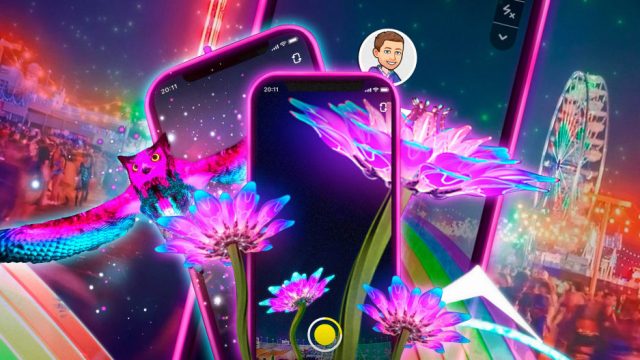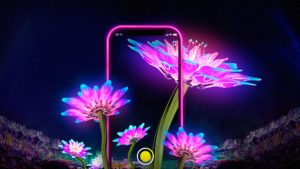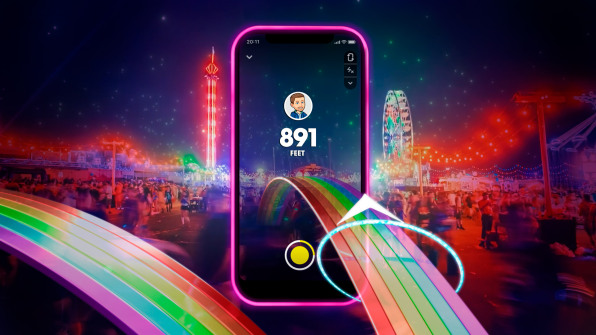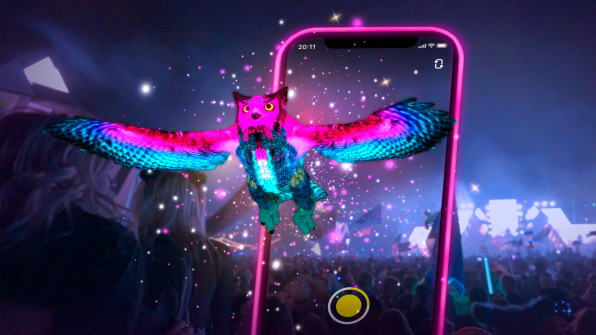- | 10:30 am
Music festivals are a UX nightmare. Here’s how Snap and Live Nation are fixing them
Snap’s new lenses debut at the Electric Daisy Carnival, where they’ll provide maps, set lists, and directions to your friends in the crowd.

The Electric Daisy Carnival is the largest electronic dance music festival in the U.S., welcoming 100,000 fans to Las Vegas to visit a psychedelic world, mostly after dark.
But like at any giant music festival, finding the right stage and meeting up with your friends in the crowd can be a total pain. Which is why the concert company Live Nation teamed up with Snap to transform Snapchat into what you might think of as a playbill for the 21st century: It’s a reference tool to offer you basic information like the run of show, extra content developed around the programming, and a platform for future marketing opportunities.
Through several new lenses, Snap will help you navigate to the right stage, check set lists, and even beeline directly to your friends through the crowd. And, of course, the app will provide some of Snap’s fantastical AR lenses, too. Playing off EDC’s own iconography, there will be three-story bioluminescent mushrooms that sprout from the ground where you tap, and a dragon-sized owl that will fly through the sky for your snaps.
The work was teased earlier this year, as Snap announced a multiyear partnership with Live Nation to provide AR experiences for its shows. Despite all the unrealized hype around augmented reality, the size and impact of this particular partnership shouldn’t be ignored. With at least a dozen festivals planned together thus far, the companies’ efforts represent the very real future of the concert experience, in which AR will not merely provide some fun flair for selfies but will also serve as a tool to enhance the UX of visiting a crowded concert.
“We’re taking advantage of the screen, and not making it a distraction,” says Kevin Chernett, EVP of global content for Live Nation. “It’s about discovery, walking around, and finding new things. Our fans are opening Snap anyway! That’s the reality.”
Snap is, for all intents and purposes, the largest AR company in the world—and perhaps the only truly successful one. Some 250 million Snapchatters use its AR lenses a total of 6 billion times daily. Meanwhile, Live Nation bills itself as the “world’s leading live entertainment company.” With $6 billion in revenue last year, the company has snowballed over the last decade to oversee the end-to-end experience of concerts. Live Nation owns many of its venues, sells its own tickets, and manages many of its artists.

[Image: Snap Inc.]
With all that control, Live Nation wants to ensure its fans have a great time. And as hectic as music festivals may look, these are highly planned and controlled environments—which in many ways makes them the perfect test bed for pushing the bounds of augmented reality.We see that play out in the first AR “lens” that Snap has built for EDC. It’s a 3D map of the festival, complete with 20 animated landmarks, including giant glowing sculptures and stages. Load it up, and the map spins in your hand until it orients with your cardinal direction. Tilt your phone ever so slightly, and you can see a clearer overhead view. Tap on any of the stages, and the map will pull up a schedule and set list. And if you still don’t know how to make your way to the stage, you can pull up a compass that will point the way. As you walk, a number dial ticks down how many feet you are away from your destination.
“We were not only thinking through, how do we use AR to enhance the experience in how you communicate with friends . . . but how do we address [practical] problems,” says Jeff Miller, GM at Snap’s creative partnership studio Arcadia. “Finding the performances you’re excited for is a common hurdle . . . [the] compass is essentially a personal guide for every festival goer.”
For any concert, this map and compass would be handy (and indeed, festivals are incorporating mapping tools more regularly). For EDC, which holds its map as a treasured secret until the doors open, it’ll be essential.

[Image: Snap Inc.]
To not spoil the surprise, we agreed to post this story without visuals of the map. What I can say is that the map is dazzling on the screen—more detailed than many video game maps. It’s also 1:1 accurate with the festival grounds, because Snap imported the exact models created by Insomniac Events, which developed much of EDC’s in-person experience. Snap also built the underlying technology, so its maps and way-finding should be dependable, even in crowded concert settings where the cell towers are overloaded.
Alongside the map, Snap will also be launching a feature in beta called FriendFind AR. In a nutshell, it’s a compass that will point you not to a stage, but directly to a friend on Snap who’s in the area.“Trying to find your friend at a festival is a huge problem we’ve been trying to solve for years,” Chernett says. “This is just a 1.0 version, but over time, we’re really focused on making this a great product. We’ve already heard from fans they want that.”
The feature is actually a riff on Snap’s existing Snap Map, which shows the location of your friends on a 2D map. (This is an opt-in experience, and you can only see friends who have friended you back.) FriendFind AR takes this same information and maps it into 3D space, where you use a compass to navigate your way toward someone else. Yes, it’s a compass again, rather than a more detailed path to your destination.
But Miller notes that this is by design. When pushing through a crowd, it’s much easier to reference cardinal directions than some overwrought turn-by-turn instructions. And because of the chaos of any concert space, the app also vibrates your phone when you’re faced the right way, lessening your reliance on the pixels. The only potential issue is that FriendFind AR requires a data connection to work, so its reliability could be rocky.

[Image: Snap Inc.]
“There are lots of ideas we can incorporate to enhance the business,” says Chernett, who notes that soon you might try on a piece of merchandise virtually at a concert and buy it, all without having to navigate to the merch booth. He also adds that Live Nation is working with several solo artists at the moment to figure out how AR might enhance tours at stadiums, arenas, and amphitheaters.
“It’s all live engagement, the music, artist, performance, fans: You’re in a live environment. That’s our bread and butter as a company,” Chernett says. “But there are so many ways to engage with live. It doesn’t always have to be the performance.”





































